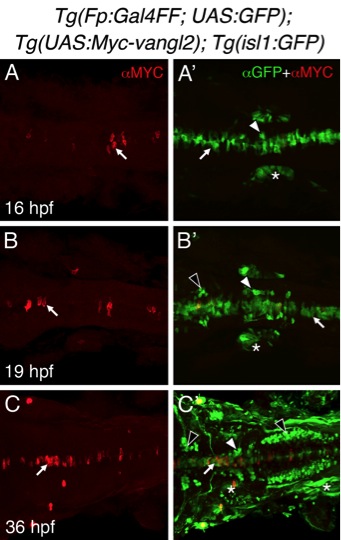Fig. S7
Tg(Fp:Gal4FF), and Tg(UAS:Myc-vangl2) transgenes induce mosaic expression of Myc-Vangl2 in the floor plate.
(A-C′) Dorsal views of the hindbrain in Tg(Fp:Gal4FF); Tg(UAS:GFP); Tg(UAS:Myc-vangl2); Tg(isl1:GFP) embryos stained with anti-MYC antibody to label Myc-Vangl2-expressing cells (A-C, red) and anti-GFP antibody to label UAS:GFP-expressing cells and isl1:GFP-expressing branchiomotor neurons (A′-C′, green). The UAS:GFP transgene is expressed at all ages in floor plate cells (A′-C′, arrows). Gal4FF induces mosaic expression of the UAS:Myc-Vangl2 transgene in the floor plate (A-C, arrows). The isl1:GFP transgene is expressed in FBM neurons (A′-C′, white arrowheads), and in the trigeminal and vagal motor neurons (B′,C′, black arrowheads). Asterisks (A′-C′) indicate Gal4FF-driven expression of the UAS:GFP transgene in the otic vesicle, trunk muscles, and skin. The Gal4FF driver does not induce UAS:GFP expression in branchiomotor neurons.
Reprinted from Developmental Biology, 382(2), Sittaramane, V., Pan, X., Glasco, D.M., Huang, P., Gurung, S., Bock, A., Li, S., Wang, H., Kawakami, K., Matise, M.P., and Chandrasekhar, A., The PCP protein Vangl2 regulates migration of hindbrain motor neurons by acting in floor plate cells, and independently of cilia function, 400-412, Copyright (2013) with permission from Elsevier. Full text @ Dev. Biol.

